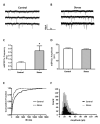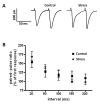Effects of stress on AMPA receptor distribution and function in the basolateral amygdala
- PMID: 23644586
- PMCID: PMC3884034
- DOI: 10.1007/s00429-013-0557-z
Effects of stress on AMPA receptor distribution and function in the basolateral amygdala
Abstract
Stress is a growing public health concern and can lead to significant disabilities. The neural response to stressors is thought to be dependent on the extended amygdala. The basolateral amygdala (BLA) is responsible for associations of sensory stimuli with emotional valence and is thought to be involved in stress-induced responses. Previous behavioral and electrophysiological experiments demonstrate that, in response to stress, changes occur in glutamatergic neurotransmission within the BLA and, in particular in transmission at AMPA receptors. Given the established role of AMPA receptors in memory and synaptic plasticity, we tested the hypothesis that stress produces alterations in the distribution of these receptors in a way that might account for stress-induced alterations in amygdala circuitry function. We examined the subcellular localization of GluR1 subunits of the AMPA receptor and the electrophysiological characteristics of BLA principal neurons in an animal model of unpredictable stress. Compared to controls, we demonstrated an increase in the ratio of labeled spines to labeled dendritic shafts in the BLA of rats 6 and 14 days post-stress, but not 1 day post-stress. Furthermore, the frequency of mini-EPSCs was increased in stressed animals without a change in general membrane properties, mini-EPSC amplitude, or in paired pulse modulation of glutamate release. Taken together, these data suggest that the shift of GluR1-containing AMPA receptors from dendritic stores into spines may be in part responsible for the persistent behavioral alterations observed following severe stressors.
Figures





References
-
- Brunetti M, Sepede G, Mingoia G, Catani C, Ferretti A, Merla A, Del Gratta C, Romani GL, Babiloni C. Elevated response of human amygdala to neutral stimuli in mild post traumatic stress disorder: neural correlates of generalized emotional response. Neuroscience. 2010;168(3):670–679. - PubMed
-
- Davis M, Rainnie D, Cassell M. Neurotransmission in the rat amygdala related to fear and anxiety. Trends Neurosci. 1994;17(5):208–214. - PubMed
-
- Davis M, Walker DL, Lee Y. Roles of the amygdala and bed nucleus of the stria terminalis in fear and anxiety measured with the acoustic startle reflex. Possible relevance to PTSD. Annals of the New York Academy of Sciences. 1997;821:305–331. - PubMed
Publication types
MeSH terms
Substances
Grants and funding
LinkOut - more resources
Full Text Sources
Other Literature Sources
Medical

